 Cornell planners have spent thousands of hours helping to rebuild New Orleans's Ninth Ward—and make the devastated neighborhood more livable than it was before Hurricane Katrina
Cornell planners have spent thousands of hours helping to rebuild New Orleans's Ninth Ward—and make the devastated neighborhood more livable than it was before Hurricane Katrina 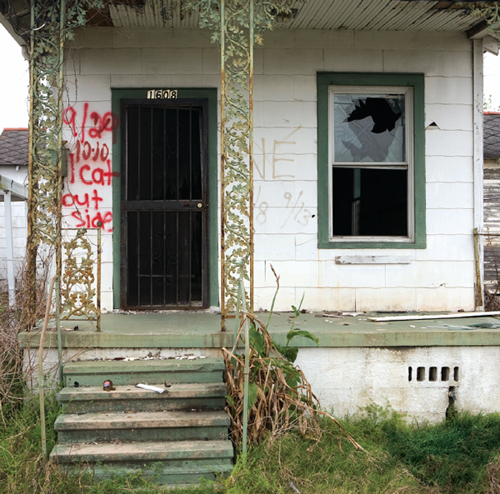
Cornell planners have spent thousands of hours helping to rebuild New Orleans's Ninth Ward—and make the devastated neighborhood more livable than it was before Hurricane Katrina
"I feel like I'm at a bus stop," Deanna Misko tells her dinner companions. "I'm so tired of being in this transitional state. I don't want a handout. I just want to get back home. I just want to get back to my life."
It's the Wednesday before Easter, and Misko is sitting in a Cajun restaurant outside Biloxi, Mississippi, where tables have been pushed together to accommodate nearly two dozen people—thirteen Cornell students and their professor, several other faculty and staff, and Misko and her seven-year-old daughter, Delony. Plates are heaped with local delicacies like gumbo, po-boys, fried okra, jalapeño hush puppies, and red beans and rice; the iced tea flows freely, poured "sweet" or "unsweet" according to taste. While the little girl plays with her mother's cellphone and nibbles on deep-fried pickles, Misko describes life on the Gulf Coast two and a half years after her D'Iberville neighborhood was nearly wiped off the map by Hurricane Katrina.
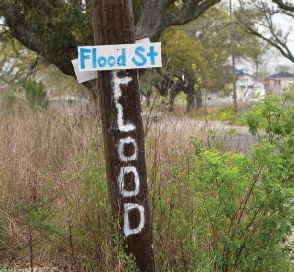
"People have kind of given up," says Misko, a forty-one-year-old single mother who worries that the FEMA trailer she and her daughter lived in for two years gave off formaldehyde fumes that could affect their long-term health. "People from out of state say they can spot a Katrina survivor, because we're like zombies. We get to an intersection with a four-way stop and we don't know who stopped first, we're just so out of it." Although her roots in the community run deep, she's thinking of moving. "All this ugliness is disheartening and depressing," she says. "I want to go someplace that's pretty and clean."
A former Biloxi police officer, Misko spent two years in a paid job coordinating the scores of volunteers who offered help after the hurricane. That's how she met George Frantz '80, MRP '91, a visiting lecturer and practicing city planner who came to the Gulf Coast in January 2006 as part of a Cornell Catholic group. He's been back to the area half a dozen times, the latest being the spring break trip that's part of a course he's teaching in the Department of City and Regional Planning. The four-credit field workshop is called Imagining a Sustainable Ninth Ward, but Frantz wants his students to see a wider picture beyond the historically poor New Orleans neighborhood whose near destruction has gotten so much press in the years since Katrina.
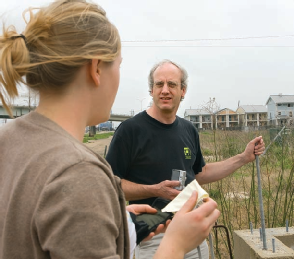
So on this Wednesday, he and graduate student Doug Swarts drove rented minivans east from New Orleans. They stopped in the hamlet of Pearlington, Mississippi, which Katrina had slammed with 135-mile-per-hour winds and tidal surges up to twenty-five feet high; where the Pearlington post office once stood, they got a tour of a Presbyterian disaster relief village, a camp of blue-and-white semi-permanent structures where volunteers stay for weeklong stints to help the town rebuild. On the coastal road to Biloxi, they took pictures of a tent church whose sign declares, "Katrina was big, but God is bigger." (Later, Frantz tells his passengers that some locals watched them and muttered the word "tourists," and not in a nice way.) As their van pulled into Biloxi, they noticed how shiny and whole the casinos seemed compared with most everything around them. At dinner with Misko, the subject of the casinos—specifically, her belief that, as far as the local government is concerned, Katrina conveniently cleared poor families off land coveted by the gaming industry— comes up more than once. "The ones that care are people like y'all," she tells the visitors from Ithaca. "The people that run this state—I don't see it from them."
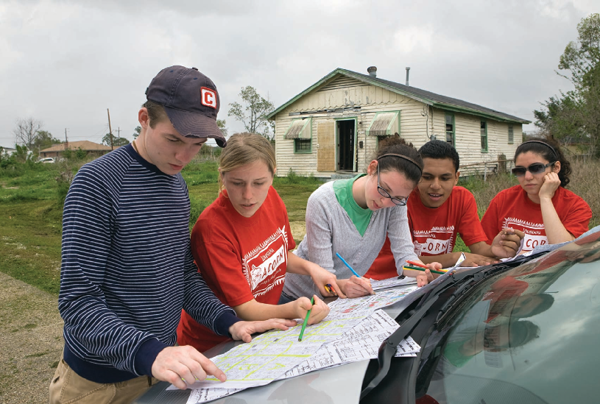
By now, it has become a familiar story—the sad fact that, two and a half years since a category-five hurricane devastated the coasts of Louisiana and Mississippi in late August 2005, many communities have barely begun to recover. Misko talks about how Gulf Coast residents like herself are "hurt and insulted" at how the region has been ignored compared to New Orleans. But even the famed Big Easy, the focus of so much volunteer labor and star wattage, has hardly bounced back. "Big Plans Are Slow to Bear Fruit in New Orleans," announced a New York Times headline shortly after the Cornellians got back to campus. Throughout their visit, local officials had referred to the city's current population as roughly two-thirds of pre-storm levels; the Times story noted that the latest census figures, at 239,000, actually put it at just over half.
'I think ten years from now, we'll see a vibrant community there. But it takes a long time. The recovery is just glacial.'While the French Quarter's Bourbon Street is rife with tipsy spring breakers, and tourists flock to Café du Monde for café au lait and beignets, other parts of the city remain ghostlike: shuttered stores, abandoned houses, fenced-off municipal buildings, vacant lots. Frantz compares New Orleans immediately post-Katrina to the cities of Germany after World War II. "After the bombing stopped, the economy was shot," he says. "Much of the population was displaced. Services were shattered. Businesses were struggling because there were no customers and no workers." Katrina, he says, "exposed the incredible weakness of the New Orleans economy." At a meeting Wednesday morning, a leader of the nonprofit Association of Community Organizations for Reform Now (ACORN) gave the students an unvarnished view of the status of the Ninth Ward, the focus of Cornell's planning efforts. "It's a miserable situation," said Wade Rathke, chief organizer for ACORN, which is headquartered in New Orleans. "We take the long view. I think ten years from now, we'll see a vibrant community there. But three years? I don't know. It takes a long time. The recovery is just glacial. It has been very, very slow."
Cornell has been involved with the Ninth Ward rebuilding effort practically from the beginning. Within weeks of the storm—with some in the city calling for much of the neighborhood to be leveled and turned into a park—ACORN contacted the planning department for help. "The Ninth Ward wasn't a great place to live—it had poor schools and poor transportation—but for many African Americans, it was home," says Richard Hayes, PhD '77, ACORN's director of strategic projects. "Multiple generations of families lived next door to one another or down the street. Not to rebuild it was to evict a lot of people from the only place they could live." The University responded by scrambling to offer a two-credit course in the second half of fall semester 2005, giving three dozen undergrads and grad students a basic grounding in the issues facing the region. Students raised more than $20,000 to fund weekend trips to gut the sodden contents and interior walls of flooded houses, vital to staving off mold and further decay. Cornell helped fund the region's first recovery planning conference, held in Baton Rouge, and in the spring of 2006 the University offered four courses to address issues identified by neighborhood leaders—from alternative stormwater management techniques and methods for assessing wind and water damage to priorities for restoring municipal services after a disaster. That March, what was supposed to be a small community meeting drew 150 people to discuss Cornell's ideas. "They were enthusiastic about the work," recalls planning professor and former department chair Ken Reardon, PhD '90, "so the students got totally torqued and produced some marvelous final projects."
ACORN and the Architecture college each contributed $35,000 to support summer internships to continue the work, and the students tackled such complex questions as how to assess the value of buildings in depressed areas with few sales to offer comparisons. At ACORN's invitation, Cornell submitted a proposal to the city to become the official planners for rebuilding New Orleans's most imperiled neighborhood. "There were sixty-eight private firms—leading architectural, planning, and engineering firms from around the world," Reardon says. "The only nonprofit submission was the ACORN Housing/University Collaborative plan by our students, and they were selected."
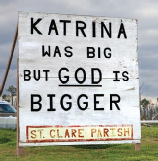 With a huge job on their hands—about six months to conduct a comprehensive review of the ward's physical, economic, and social conditions; formulate a vision for the future; and devise ways to implement it—they recruited faculty and students from Columbia and the University of Illinois, Urbana-Champaign, to join the team. Reardon estimates they devoted some 80,000 hours to the effort; in the weeks leading up to the plan's unveiling in January 2007, he says, the editing staff alone worked eighteen hours a day for two straight weeks. The work paid off: their vision, which would come to be known as the People's Plan, was ultimately incorporated into the city's master plan and enacted by the New Orleans government; it is now local law. By working the phones and hitting the pavement, the students helped prove that the Ninth Ward was worth saving. "Our plan contains irrefutable data that challenged previous reports that described the ward as being too far gone to merit reinvestment," Reardon says. "It showed that the physical structures were in much better shape than had been previously reported. A much higher percentage of residents had returned, the overwhelming majority of them were in the process of rehabbing their homes— not to sell, but to re-occupy—and each returning family was in touch with relatives who wanted to do the same but had concerns about public health, education, and employment prospects."
With a huge job on their hands—about six months to conduct a comprehensive review of the ward's physical, economic, and social conditions; formulate a vision for the future; and devise ways to implement it—they recruited faculty and students from Columbia and the University of Illinois, Urbana-Champaign, to join the team. Reardon estimates they devoted some 80,000 hours to the effort; in the weeks leading up to the plan's unveiling in January 2007, he says, the editing staff alone worked eighteen hours a day for two straight weeks. The work paid off: their vision, which would come to be known as the People's Plan, was ultimately incorporated into the city's master plan and enacted by the New Orleans government; it is now local law. By working the phones and hitting the pavement, the students helped prove that the Ninth Ward was worth saving. "Our plan contains irrefutable data that challenged previous reports that described the ward as being too far gone to merit reinvestment," Reardon says. "It showed that the physical structures were in much better shape than had been previously reported. A much higher percentage of residents had returned, the overwhelming majority of them were in the process of rehabbing their homes— not to sell, but to re-occupy—and each returning family was in touch with relatives who wanted to do the same but had concerns about public health, education, and employment prospects."
The plan itself, Reardon says, stood out because of its level of detail, the extent to which residents were consulted in its formulation, and its emphasis on making the ward a better place to live than it had been pre-Katrina. "The other consultants mostly focused on getting the chairs back in the living room and getting the bus to run down Main Street the way it used to," he says. "In the Ninth Ward, that wasn't going to provide the quality of life that we expect American citizens to have. The ward had been neglected for decades by the city administration, state and federal agencies, and even the nonprofit sector to a certain extent. So merely putting it back the way it was on August 27 was going to result in tens of thousands of people still living in challenging conditions. Ours was not a restoration plan; it was about transforming the neighborhood."
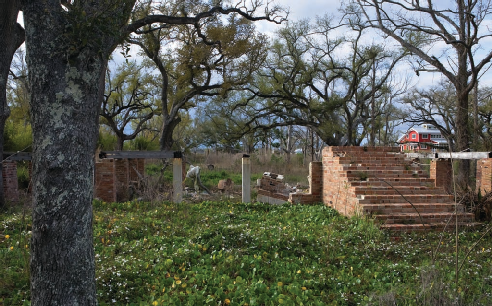 But as anyone who visits New Orleans beyond the tourist route of the French Quarter and the Garden District can attest, the city's rebuilding effort is a monumental undertaking. David Lessinger, MRP '07, who was among the early Cornell volunteers when he gutted houses as a grad student in planning, now lives in the city's Bywater area and works for Neighborhood Housing Services through a fellowship sponsored by the Rockefeller Foundation. Although he relishes the city's lively spirit and myriad dining spots, he says that living there can be tough. "You have to desensitize yourself a little bit," he says. "You have to get used to the fact that you're going to be driving by vacant houses and neighborhoods that are quieter than they should be, because otherwise it wears you down. It's too depressing. It's definitely frustrating that we're two years into the recovery and it's exceedingly slow." And while many blame the federal government—there's a local expression, "FEMA brain," which roughly translates as "idiotic"—or cite New Orleans's history of corrupt and ineffective city administration, Reardon points out that a revitalization project on this vast a scale is inherently a long-term proposition. "In a city like New York, which has not suffered that kind of horrific natural disaster, a major district development takes seven to ten years from the time it's conceived to when you cut the ribbon," he says. "I think everyone appreciates that in a situation like New Orleans it could take a substantial period of time."
But as anyone who visits New Orleans beyond the tourist route of the French Quarter and the Garden District can attest, the city's rebuilding effort is a monumental undertaking. David Lessinger, MRP '07, who was among the early Cornell volunteers when he gutted houses as a grad student in planning, now lives in the city's Bywater area and works for Neighborhood Housing Services through a fellowship sponsored by the Rockefeller Foundation. Although he relishes the city's lively spirit and myriad dining spots, he says that living there can be tough. "You have to desensitize yourself a little bit," he says. "You have to get used to the fact that you're going to be driving by vacant houses and neighborhoods that are quieter than they should be, because otherwise it wears you down. It's too depressing. It's definitely frustrating that we're two years into the recovery and it's exceedingly slow." And while many blame the federal government—there's a local expression, "FEMA brain," which roughly translates as "idiotic"—or cite New Orleans's history of corrupt and ineffective city administration, Reardon points out that a revitalization project on this vast a scale is inherently a long-term proposition. "In a city like New York, which has not suffered that kind of horrific natural disaster, a major district development takes seven to ten years from the time it's conceived to when you cut the ribbon," he says. "I think everyone appreciates that in a situation like New Orleans it could take a substantial period of time."
For the Cornell team, the focus has shifted from big-picture planning to the nuts-and-bolts of implementation. During their spring break trip, ACORN asked them to look at the potential for turning a condemned school property into a public park, and enlisted Frantz and his students to tour the Lower Ninth Ward and chronicle the state of its homes. (See sidebar.) A dozen Cornellians spent a sweaty, muddy Thursday helping clear land for a community garden in a heavily Vietnamese neighborhood in New Orleans East, whose close cultural ties and intense loyalty to the local Catholic church have led to a 95 percent return rate and the restoration of many homes. "I'm happy to come here, because things are happening," says sophomore Fernando Montejo, standing outside the offices of the Vietnamese community development corporation that has been active in the neighborhood's renaissance.
In January, Montejo and classmates Kendra Chatburn '10 and Thu Huong Nguyen '10 accompanied Reardon to New Orleans at their own expense, volunteering in the ACORN offices, gutting houses, and meeting with nonprofit officials. They and other students were the driving force behind the spring semester course, advocating—in fact, agitating—for the Ninth Ward's continued presence in the curriculum. (Chatburn refers to it as "all the drama that I and my fellow students started last semester.") City and Regional Planning underwrote the spring break trip, which cost the students $320 each toward their plane tickets; the department covered their stay in a Garden District hostel, meals, and other expenses. "We need to focus on public service as a means of education, because it's easy to have a disconnection between what you learn in class and what you actually do," Chatburn says. "When you go on a trip like this, you're able to think about the connection between the theoretical and what's happening in real time." Two weeks after their return, the students joined Reardon for a presentation at Sage Chapel—"Faith in Action: The Lower Ninth Ward's Struggle for Justice in Post-Katrina New Orleans"— describing the neighborhood's plight, complete with jazz by Ithaca musicians. "Planning is much more than design," Montejo says. "It provides a voice to people who don't have one."
Signs of Life
A minivan tour through the Lower Ninth Ward
Professor George Frantz is driving a rented minivan through the streets of greater New Orleans, past billboards offering cash for gutted houses and tacked-up signs touting handyman services, when his passengers urge him to make a U-turn. The three planning students—sophomores Kendra Chatburn and Dina Burkitbayeva and graduate student Na Jia—have spotted a lot selling prefabricated homes to replace houses damaged by Hurricane Katrina, and they want a closer look.
Frantz pulls into the parking lot, where a banner declares that a three-bedroom, two-bath, 1,320-square-foot model is available for $139,900. A genial salesman comes jogging out of the Waffle House next door, willing to interrupt his breakfast to give the Cornellians a tour. "It's not so bad," Chatburn says, sounding surprised as she inspects the molding in the living room. "They do cutesy little touches that make it a bit better." The salesman walks the group through each model—he and Frantz warm to each other as they swap information about the logistics of hauling a house on an eighteen-wheeler at highway speeds—declaring that last year, the lot had $5 million in sales. But when he learns that Frantz and the young women are bound for the city's devastated Lower Ninth Ward, he's clearly concerned. "Stay where there's people and lights," he tells them, though it's barely ten in the morning. "Last week, a guy got shot down there."
Back in the van, as the students wait for Frantz to rejoin them, they peer at the screen of a digital camera. They scroll through snapshots of Brad Pitt, whom they'd seen (along with Bill Clinton) at a volunteer cleanup near the site of the industrial levee break earlier in the week. In person, the movie star didn't live up to his on-screen hunkiness. "He looked skinny and pale," Chatburn laments, adding that Clinton didn't look particularly good either. Frantz pulls out of the parking lot and they head toward the Ninth Ward, passing a team of spring break volunteers, clad in matching T-shirts, dabbing black paint on a wrought-iron fence. Farther down the road, they drive past the temporary headquarters of St. Bernard Parish, a community just over the New Orleans city line. "Even the local governments are still operating out of trailers," Frantz observes.
When they get to the Ninth Ward, the students unfold photocopied maps; they hope to complete the project they started two days before, cataloguing roughly 1,500 properties in a sixty-block radius for the nonprofit group that recruited Cornell to help with the ward's restoration. "We're giving them a snapshot of the current situation," Frantz says, "and identifying vacant lots they could build on." He wonders aloud whether the van will be stopped by the Louisiana National Guard, which is still patrolling the neighborhood; it happened a couple of days earlier, though once he explained what the Cornell team was doing, the soldiers were perfectly friendly.
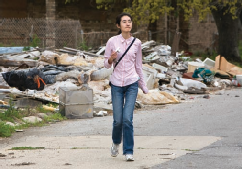
As the minivan crawls past the houses—most of them humble, rundown wooden structures on small, narrow lots—Frantz and the students debate how each should be labeled. Occupied? In the process of being restored? Simply maintained? Abandoned? Nearly all the homes have been gutted, but they look for other signs. Is the door ajar, or has it been secured? Is there a new roof? Is the lawn mowed? "That to us is an indication that somebody is coming back," Frantz explains. Most of the houses still display the spray-painted crosshatch marks made in the weeks after the hurricane, coded to indicate when it was inspected and whether any bodies were found inside. A few alert the SPCA to dead or abandoned pets; one has a giant arrow pointing to a second-story window and the words "1 DOG—YOUNG." Some houses bear names—whether of humans or animals, it's impossible to know—preceded by the letters "R.I.P."
Many of the vacant lots neighbor each other, forming swaths of unruly greenery, and Frantz reminds his passengers that some of the dilapidation and neglect preceded Katrina; it can't all be blamed on the storm. "Pre-Katrina, it was a poor residential community, but very cohesive," he says. "It had its own identity and its roots ran deep." Although much of the neighborhood is desolate, there are signs of life. A few houses are occupied, and construction crews are working on dozens of others. There's the noise of hammering and in the distance what sounds oddly like the music-box tune of an ice-cream truck. Outside a restored church, a small crowd is dressed up for Holy Thursday services. A few blocks away, the van passes a ramshackle white-and-green house whose broken windows are open to the elements. But someone must care about the property: the lawn has been mowed, so recently that the smell of spring onions wafts down the street. The team marks it "damaged, but maintained."


